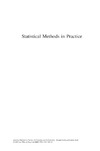This is a practical book on how to apply statistical methods successfully. The Authors have deliberately kept formulae to a minimum to enable the reader to concentrate on how to use the methods and to understand what the methods are for. Each method is introduced and used in a real situation from industry or research.
Each chapter features situations based on the authors’ experience and looks at statistical methods for analysing data and, where appropriate, discusses the assumptions of these methods.
Key features:
- Provides a practical hands-on manual for workplace applications.
- Introduces a broad range of statistical methods from confidence intervals to trend analysis.
- Combines realistic case studies and examples with a practical approach to statistical analysis.
- Features examples drawn from a wide range of industries including chemicals, petrochemicals, nuclear power, food and pharmaceuticals.
- Includes a supporting website, providing software to aid tutorials.
Scientists and technologists of all levels who are required to design, conduct and analyse experiments will find this book to be essential reading.
Content:
Chapter 1 Samples and Populations (pages 1–4):
Chapter 2 What is the True Mean? (pages 5–18):
Chapter 3 Exploratory Data Analysis (pages 19–28):
Chapter 4 Significance Testing (pages 29–39):
Chapter 5 The Normal Distribution (pages 41–52):
Chapter 6 Tolerance Intervals (pages 53–54):
Chapter 7 Outliers (pages 55–58):
Chapter 8 Significance Tests for Comparing Two Means (pages 59–69):
Chapter 9 Significance Tests for Comparing Paired Measurements (pages 71–81):
Chapter 10 Regression and Correlation (pages 83–100):
Chapter 11 The Binomial Distribution (pages 101–109):
Chapter 12 The Poisson Distribution (pages 111–119):
Chapter 13 The chi?Squared Test for Contingency Tables (pages 121–127):
Chapter 14 Non?Parametric Statistics (pages 129–138):
Chapter 15 Analysis of Variance: Components of Variability (pages 139–153):
Chapter 16 Cusum Analysis for Detecting Process Changes (pages 155–166):
Chapter 17 Rounding of Results (pages 167–171):
 |
|
О проекте
|
|
О проекте


